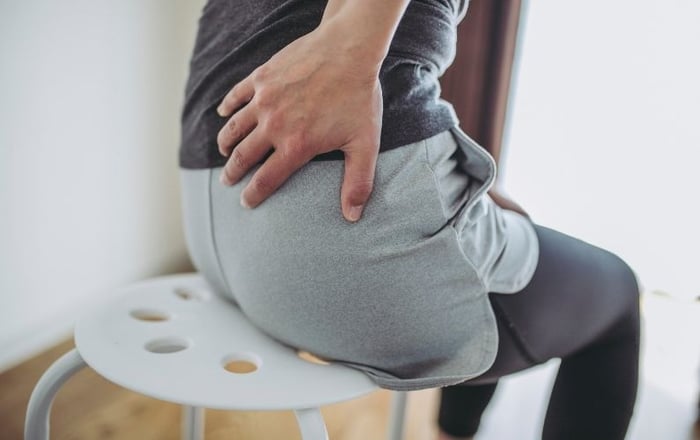Learn how to relieve back pain when working from home with exercises, lumbar support and electrotherapy.
Back pain can often come as a result of sitting stationary for long periods. Although at the beginning of the workday your posture may be nothing less than perfect, after hours of sitting in the same spot, it is common for you to find yourself hunched over.
This can lead to back pain, and if left untreated can start to have negative effects on your day-to-day life. Luckily, we have put together a well-rounded list of the 3 best fixes for back pain when working from home.
If you're asking yourself, "how can I stop my back from hurting at my desk?", keep reading.
3 Ways to Prevent Back Pain When Working From Home
1. At-Home Workouts
If you're looking for a versatile piece of equipment that isn't going to break the bank, the Rock Tape RockBand Flex Resistance Band is a great choice.
Here are two exercises you can do that will help relieve back pain from sitting at a desk.
Hamstring Stretch
You may be asking "why do a hamstring stretch for back pain?" Tight hamstrings are often a major contributor to lower back pain. This is because when your hamstrings are tight, they will pull your hips out of alignment and causes stress in your lower back.
The Rock Tape RockBand Flex Resistance Band is designed with integrated loops throughout the band that will help you easily perform many exercises. Even if you are a beginner.
Here's how to perform a hamstring stretch:
- Sit on the floor and put one foot through the center loop.
- Grab each end of the band and lay it on your back.
- While leaving the leg not in the band straight, slowly lift the leg in the band and pull on the ends of the band until you feel a comfortable stretch.
- Hold for 10 - 30 seconds.
- Then pulse your foot down and into the band for 5 - 10 reps.
- Repeat this 3 times for each leg.
This stretch exercise will help with the hip range of movement and relieve tension in your lower back.
Banded Hip Mobilization
Sitting for long periods can cause your hip flexors to become tight. This can cause anterior pelvic tilt, which is when the hips tilt forward and out of alignment. Anterior pelvic tilt can cause muscle imbalances that lead to lower back pain. Luckily, using the Rock Tape RockBand Flex Resistance Band to perform a banded hip mobilization exercise is an active stretch that will help lengthen the hip flexor and alleviate your pain.Here's what to do:
- Slip the end loops of the band over a fixed object like a pole or a sturdy table leg.
- Put your left leg through the band and pull it up to your hip.
- While kneeling on your left knee, slowly move to the end range of the band.
- While keeping your torso in the upright position, push your hips forward until you feel a comfortable stretch in your hip flexor.
- You can perform additional stretches when in this position such as trunk rotations and side bends.
- Perform this exercise 3 times on each side for 30-90 seconds.
This exercise will help reduce the tension in your lower back by lengthening your hip flexor.
2. Lumbar Supports
Many of us are working from home and sitting for up to 8 hours each day. We must give our bodies the proper support to prevent back pain. This often comes in the form of a high-quality ergonomic desk chair with integrated lumbar support. It also typically comes with a hefty price tag. Luckily, there is a more affordable solution.
Dr. Ho's PerfectBack Rest is engineered with 16 pressure point massagers to soothe achy muscles. It makes any chair in the office, car, and home a chair with the perfect back. It has an ergonomic curved shape to help restore the spine's natural curve while promoting a healthy posture.
In addition to this, it can also use it as a spinal bridge to stretch the spine. All you need to do is lay the PerfectBack Rest on the floor and then slowly lower your back onto it. Relax in this position for up to 60 seconds to help elevate any back pain.
3. TENS Therapy
Rounding up this list is Dr. Ho's Pain Therapy System. This is a 4 pad TENS device that is ideal for managing back pain. Transcutaneous electrical nerve stimulation (TENS) is a device that sends small electrical impulses through pads that you attach to your skin. These impulses stimulate the nervous system, both reducing pain signals sent to your brain as well as helping to produce endorphins (natural pain killers). They also help improve blood circulation.
To use Dr. Ho's Pain Therapy System, simply attach the sticky side of the pads to the affected area. Next, turn the device on until you feel your muscles contract and relax. It is best to do this while you are seated. If your back is aching mid-day, you can put this device on and get back to work without having to take a break. Leave it on for at least 20 minutes to feel the full effect. You can use it anywhere from 1-5 times per day, depending on your level of pain. It also comes with a convenient personal travel bag, so you can bring it with you when you're on the go.
However, there are a few caveats:
- If you are pregnant, avoid using it on the pelvic and abdominal regions.
- If you have epilepsy, avoid using it on your head or neck.
- If you have heart problems, a pacemaker or any other electrical or metal implant avoid TENS devices altogether.
Closing Thoughts
As you spend more time working at a desk, back pain is something that will surely arise. We hope this list helped you find some ways to reduce your back pain at home.
Finally, if you're looking for even more ways to relieve back pain at home, check out more fitness, support, and electrotherapy products to help you live more comfortably.
Want to learn more about back pain? Check these posts out:
















